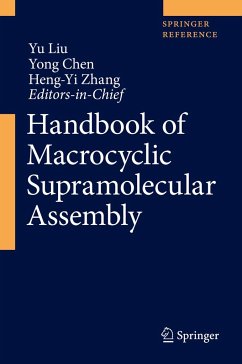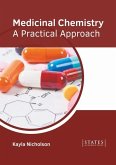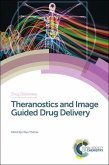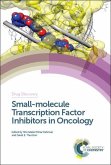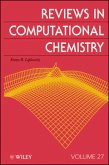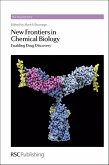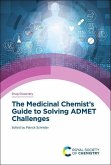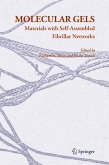Handbook of Macrocyclic Supramolecular Assembly
Herausgeber: Liu, Yu; Zhang, Heng-Yi; Chen, Yong
Handbook of Macrocyclic Supramolecular Assembly
Herausgeber: Liu, Yu; Zhang, Heng-Yi; Chen, Yong
- Gebundenes Buch
- Merkliste
- Auf die Merkliste
- Bewerten Bewerten
- Teilen
- Produkt teilen
- Produkterinnerung
- Produkterinnerung
This handbook presents recent advances and offers a comprehensive reference resource covering the developments in and applications of macrocyclic supramolecular assembly, with a focus on their construction, structural characters and biological functions. The main topics addressed include: 1. Construction and structure of macrocyclic supramolecular assembly - key building blocks, construction methods, structural motifs, and stimuli responsive control 2. Approach and technology - controllable synthesis, molecular recognition, spectral and thermodynamic study, supramolecular assembly at…mehr
Andere Kunden interessierten sich auch für
![Medicinal Chemistry: A Practical Approach Medicinal Chemistry: A Practical Approach]() Medicinal Chemistry: A Practical Approach156,99 €
Medicinal Chemistry: A Practical Approach156,99 €![Theranostics and Image Guided Drug Delivery Theranostics and Image Guided Drug Delivery]() Theranostics and Image Guided Drug Delivery267,99 €
Theranostics and Image Guided Drug Delivery267,99 €![Small-Molecule Transcription Factor Inhibitors in Oncology Small-Molecule Transcription Factor Inhibitors in Oncology]() Small-Molecule Transcription Factor Inhibitors in Oncology222,99 €
Small-Molecule Transcription Factor Inhibitors in Oncology222,99 €![Reviews in Computational Chemistry, Volume 27 Reviews in Computational Chemistry, Volume 27]() Reviews in Computational Chemistry, Volume 27284,99 €
Reviews in Computational Chemistry, Volume 27284,99 €![New Frontiers in Chemical Biology New Frontiers in Chemical Biology]() New Frontiers in Chemical Biology198,99 €
New Frontiers in Chemical Biology198,99 €![Medicinal Chemist's Guide to Solving Admet Challenges Medicinal Chemist's Guide to Solving Admet Challenges]() Medicinal Chemist's Guide to Solving Admet Challenges253,99 €
Medicinal Chemist's Guide to Solving Admet Challenges253,99 €![Molecular Gels Molecular Gels]() Richard G. Weiss / Pierre Terech (eds.)Molecular Gels245,99 €
Richard G. Weiss / Pierre Terech (eds.)Molecular Gels245,99 €-
-
-
This handbook presents recent advances and offers a comprehensive reference resource covering the developments in and applications of macrocyclic supramolecular assembly, with a focus on their construction, structural characters and biological functions. The main topics addressed include: 1. Construction and structure of macrocyclic supramolecular assembly - key building blocks, construction methods, structural motifs, and stimuli responsive control 2. Approach and technology - controllable synthesis, molecular recognition, spectral and thermodynamic study, supramolecular assembly at interfaces, orthogonal self-assembly, the supramolecular organic framwork (SOF), molecular induced aggregation, supramolecule assisted 3D printing, theoretical calculation and molecular simulation 3. Biological applications - chemical and biological sensing, theranostic tools, molecule/ion channels, drug/gene delivery, supramolecule assisted biomolecule production, supramolecule assisted transmembrane transport, supramolecule assisted immunity regulation, supramolecule-based medicinal drug, etc. This handbook appeals to graduate and undergraduate students as well as scientists with interests in supramolecular chemistry, biochemistry, functional material and nanotechnology.
Hinweis: Dieser Artikel kann nur an eine deutsche Lieferadresse ausgeliefert werden.
Hinweis: Dieser Artikel kann nur an eine deutsche Lieferadresse ausgeliefert werden.
Produktdetails
- Produktdetails
- Verlag: Springer London / Springer Singapore
- 2020
- Seitenzahl: 1719
- Erscheinungstermin: 23. August 2020
- Englisch
- ISBN-13: 9789811526879
- ISBN-10: 9811526877
- Artikelnr.: 58416149
- Herstellerkennzeichnung
- Libri GmbH
- Europaallee 1
- 36244 Bad Hersfeld
- 06621 890
- Verlag: Springer London / Springer Singapore
- 2020
- Seitenzahl: 1719
- Erscheinungstermin: 23. August 2020
- Englisch
- ISBN-13: 9789811526879
- ISBN-10: 9811526877
- Artikelnr.: 58416149
- Herstellerkennzeichnung
- Libri GmbH
- Europaallee 1
- 36244 Bad Hersfeld
- 06621 890
Yu Liu is a professor at Nankai University. He received his Ph.D. from Himeji Institute of Technology, Japan, in 1991. Then, he spent about 2 years (1991-1992) as postdoctoral fellow at Lanzhou Institute of Chemical Physics. In 1993, he moved to Nankai University as a professor and got the special government allowances of the State Council. Prof. Liu obtained the support of National Outstanding Youth Fund in 1996 and is now the specially appointed professor of Cheung Kong Scholars Programme. He has made a great deal of contribution to the supramolecular chemistry of crown ether, cyclodextrin, and calixarene, and is the contributor of 8 books and more than 500 articles (h-index: 61). Prof. Liu won a Second Class Award of Natural Science from Chinese Academy of Science in 1990; a Second Class Award of Scientific and Technological Progress from Ministry of Education in 1998; three times First Class Award of Natural Science of Tianjin in 2000, 2005, and 2015; a Second Class Award of State Natural Science Prize in 2010, and a Special Grade Award of Baogang Outstanding Teacher in 2003. Yong Chen obtained his Ph.D. degree in 2001 from Nankai University (China), majoring in physical organic chemistry. From 2002 to 2003, he was an assistant professor at the Institute of Chemistry, Chinese Academy of Science. Subsequently, Prof. Chen went to Ecole Normale Superieure (ENS, France) as a post-doctor in 2002 via invitation from National Scientific Research Center of France (CNRS). At the end of 2003, he joined the Supramolecular Chemistry Laboratory of Nankai University as an associate professor and became a professor in 2009. Prof. Chen's research interests are mainly focused on supramolecular chemistry of cyclodextrins and cucurbiturils. Heng-Yi Zhang born in Anhui Province of China, in 1965, is a professor of Nankai University (Tianjin, China). He received his M.S. degree from Anshan Research Institute of Thermal Energy in 1994 and his Ph.D. from Nankai University in 2000. In the same year, he became a lecturer of Nankai University and a professor in 2005. His current research interests focus on molecular recognition and molecular assembly based on the macrocyclic compounds including crown ether, cyclodextrin, and cucurbituril. Prof. Zhang is the contributor of 4 books and more than 130 research papers. In addition, He won one Second Class Award of State Natural Science Prize in 2010, two First Class Award of Natural Science Prize by Tianjin in 2005 and 2015, and one Second Class Award of Natural Science Prize by Ministry of Education in 2002.
Section 1. Supramolecular Assemblies Based on Crown Ethers and Cyclophanes.
Chapter 1. Water
Soluble Aromatic Crown Ethers: from Molecular Recognition to Molecular Assembly.
Chapter 2. Polypseudorotaxanes Constructed by Crown Ethers.
Chapter 3. Host
Guest Chemistry of A Macrocycle Containing p Systems Namely Cyclobis(paraquat
p
phenylene).
Chapter 4. Mechanically Selflocked Molecules.
Chapter 5. Photo
luminescent Crown Ether Assembly. Section 2. Supramolecular Assemblies Based on Macrocyclic Arenes.
Chapter 1. Triptycene Derived Macrocyclic Arenes: from Calixarenes to Helicarenes.
Chapter 2. General Introduction of Some Emerging Macrocyclic Arenes Related to Calixarenes and Pillararenes.
Chapter 3. Macrocyclic Amphiphiles for Nanomedicine.
Chapter 4. Preparation of Biosensor Based on Supermolecular Recognizaiton.
Chapter 5. Application of Anion
Pi Interaction on Supramolecular Self
Assembly.
Chapter 6. Functional Rotaxanes: from Synthetic Methodology to Functional Molecular Materials.
Chapter 7. Biphen[n]arenes: Synthesis and Host
Guest Properties.
Chapter 8. Pillararene
based Supramolecular Polymer. Section 3. Supramolecular Assemblies Based on Cyclodextrins.
Chapter 1. Functionalized Cyclodextrins and Their Applications.
Chapter 2. Cyclodextrin Polyrotaxanes: Synthesis, Analytics and Functions.
Chapter 3. Cyclodextrin Hybrid Inorganic Nanocomposites for Molecular Recognition, Selective Adsorption and Drug Delivery.
Chapter 4. Photoresponsive Supramolecular Assembly with Biological Function.
Chapter 5. Cyclodextrin
based Supramolecular Hydrogel.
Chapter 6. Supramolecular Chiral Photochemistry.
Chapter 7. Construction and Functions of Supramolecular Cyclodextrin Polymer.
Chapter 8. Construction of Cyclodextrin
based Magnetic Supramolecular Assemblies and Its Regulation of Cell Mobility.
Chapter 9. Supramolecular Assemblys Based on Multi
Charge Cyclodextrin Induced Aggregation. Section 4. Supramolecular Assemblies Based on Cucurbiturils.
Chapter 1. Stimuli Responsive Self
Assembly Based on Macrocyclic Hosts and Biomedical Applications.
Chapter 2. Modulation of Chemical and Biological Properties of Biomedically Relevant Guest Molecules by Cucurbituril
type Hosts.
Chapter 3. Self
Assembled Two
Dimensional Organic Layers in Solution Phase.
Chapter 4. Modified Cucurbiturils with Various Ring Size: Synthesis.
Chapter 5. Modified Cucurbiturils with Various Ring Size: Assembly.
Chapter 6. Modified Cucurbiturils with Various Ring Size: Functions.
Chapter 7. Biological Systems Involving Cucurbituril.
Chapter 8. Cucurbituril
based Pseudorotaxanes and Rotaxanes.
Chapter 9. Construction of Supramolecular Networks Based on CB8. Section 5. Supramolecular Assemblies Based on Other Macrocycles.
Chapter 1. Supramolecular Catalysis Using Functional Organic Macrocycles and Molecular Cages.
Chapter 2. Porphyrins and Porphyrinoids: Syntheses, Structures, and Properties.
Chapter 3. Protein Self
Assembly: Strategies and Applications.
Chapter 4. Peptide Tectonics: towards Biomimetic and Bioinspired Soft Materials.
Chapter 5. Naphthol
based Macrocycles.
Chapter 6. Carbohydrate
based Macromolecular Self
Assembly.
Chapter 7. in vivo Self
Assembly of Polypeptide
based Nanomaterials.
Chapter 8. Construction of Well
Defined Discrete Metallacycles and Their Biological Applications. Section 6. Some Important Approaches in Macrocycle
based Supramolecular Chemistry.
Chapter 1. Molecular Simulations of Supramolecular Architectures.
Chapter 2. Thermodynamic Studies of Supramolecular Systems.
Chapter 3. Spectral Studies of Supramolecular Systems.
Chapter 4. Artificial Host Molecules Modifying Biomacromolecules.
Chapter 5 Controllable Synthesis of Polynuclear Metal Clusters within Macrocycles.
Chapter 6 Integrating Macrocyclic Rings into Functional 3D Printing Materials.
Chapter 7 Molecular Recognition with Helical Receptors.
Chapter 8 Supramolecular Interface for Biochemical Sensing Applications.
Chapter 9 Supramolecular Functional Complexes Constructed by Orthogonal Self
Assembly.
Chapter 10 Aggregation Induced Emission of Macrocycle
based Assemblies.
Chapter 11 Application of Rare Earth Metal Complexes in Macrocycle
based Assemblies.
Chapter 12 Two Dimensional Supramolecular Framwork Based on Host
Guest Self
Assembly. Section 7. Biological Applications.
Chapter 1. Theranostic Supramolecular Vesicle Systems.
Chapter 2. Host
Guest Sensing by Nanopores and Nanochannels.
Chapter 3. Highly Selective Ultrafast Proton Transport by Synthetic Unimolecular Proton Channels.
Chapter 4.Drug/Gene Delivery Platform Based on Supramolecular Interactions: Hyaluronic Aicd and Folic Acid as Targeting Units.
Chapter 5. Self
Assembling Peptides for Vaccine Development and Antibody Production.
Chapter 6. Supramolecules Assisted Transport of Ions and Molecules through Lipid Bilayers.
Chapter 7. Construction and Biomedical Applications of Macrocycle
based Supramolecular Topological Polymers.
Chapter 8. Supermolecules as Medicinal Drugs.
Chapter 9. Nanoscaled Cyclodextrin Supermolecular System for Drug and Gene Delivery.
Chapter 10. Immunity Regulation by Cyclodextrin
based Supramolecular Assembly.
Chapter 11. Industrial Application of Cyclodextrin.
Chapter 1. Water
Soluble Aromatic Crown Ethers: from Molecular Recognition to Molecular Assembly.
Chapter 2. Polypseudorotaxanes Constructed by Crown Ethers.
Chapter 3. Host
Guest Chemistry of A Macrocycle Containing p Systems Namely Cyclobis(paraquat
p
phenylene).
Chapter 4. Mechanically Selflocked Molecules.
Chapter 5. Photo
luminescent Crown Ether Assembly. Section 2. Supramolecular Assemblies Based on Macrocyclic Arenes.
Chapter 1. Triptycene Derived Macrocyclic Arenes: from Calixarenes to Helicarenes.
Chapter 2. General Introduction of Some Emerging Macrocyclic Arenes Related to Calixarenes and Pillararenes.
Chapter 3. Macrocyclic Amphiphiles for Nanomedicine.
Chapter 4. Preparation of Biosensor Based on Supermolecular Recognizaiton.
Chapter 5. Application of Anion
Pi Interaction on Supramolecular Self
Assembly.
Chapter 6. Functional Rotaxanes: from Synthetic Methodology to Functional Molecular Materials.
Chapter 7. Biphen[n]arenes: Synthesis and Host
Guest Properties.
Chapter 8. Pillararene
based Supramolecular Polymer. Section 3. Supramolecular Assemblies Based on Cyclodextrins.
Chapter 1. Functionalized Cyclodextrins and Their Applications.
Chapter 2. Cyclodextrin Polyrotaxanes: Synthesis, Analytics and Functions.
Chapter 3. Cyclodextrin Hybrid Inorganic Nanocomposites for Molecular Recognition, Selective Adsorption and Drug Delivery.
Chapter 4. Photoresponsive Supramolecular Assembly with Biological Function.
Chapter 5. Cyclodextrin
based Supramolecular Hydrogel.
Chapter 6. Supramolecular Chiral Photochemistry.
Chapter 7. Construction and Functions of Supramolecular Cyclodextrin Polymer.
Chapter 8. Construction of Cyclodextrin
based Magnetic Supramolecular Assemblies and Its Regulation of Cell Mobility.
Chapter 9. Supramolecular Assemblys Based on Multi
Charge Cyclodextrin Induced Aggregation. Section 4. Supramolecular Assemblies Based on Cucurbiturils.
Chapter 1. Stimuli Responsive Self
Assembly Based on Macrocyclic Hosts and Biomedical Applications.
Chapter 2. Modulation of Chemical and Biological Properties of Biomedically Relevant Guest Molecules by Cucurbituril
type Hosts.
Chapter 3. Self
Assembled Two
Dimensional Organic Layers in Solution Phase.
Chapter 4. Modified Cucurbiturils with Various Ring Size: Synthesis.
Chapter 5. Modified Cucurbiturils with Various Ring Size: Assembly.
Chapter 6. Modified Cucurbiturils with Various Ring Size: Functions.
Chapter 7. Biological Systems Involving Cucurbituril.
Chapter 8. Cucurbituril
based Pseudorotaxanes and Rotaxanes.
Chapter 9. Construction of Supramolecular Networks Based on CB8. Section 5. Supramolecular Assemblies Based on Other Macrocycles.
Chapter 1. Supramolecular Catalysis Using Functional Organic Macrocycles and Molecular Cages.
Chapter 2. Porphyrins and Porphyrinoids: Syntheses, Structures, and Properties.
Chapter 3. Protein Self
Assembly: Strategies and Applications.
Chapter 4. Peptide Tectonics: towards Biomimetic and Bioinspired Soft Materials.
Chapter 5. Naphthol
based Macrocycles.
Chapter 6. Carbohydrate
based Macromolecular Self
Assembly.
Chapter 7. in vivo Self
Assembly of Polypeptide
based Nanomaterials.
Chapter 8. Construction of Well
Defined Discrete Metallacycles and Their Biological Applications. Section 6. Some Important Approaches in Macrocycle
based Supramolecular Chemistry.
Chapter 1. Molecular Simulations of Supramolecular Architectures.
Chapter 2. Thermodynamic Studies of Supramolecular Systems.
Chapter 3. Spectral Studies of Supramolecular Systems.
Chapter 4. Artificial Host Molecules Modifying Biomacromolecules.
Chapter 5 Controllable Synthesis of Polynuclear Metal Clusters within Macrocycles.
Chapter 6 Integrating Macrocyclic Rings into Functional 3D Printing Materials.
Chapter 7 Molecular Recognition with Helical Receptors.
Chapter 8 Supramolecular Interface for Biochemical Sensing Applications.
Chapter 9 Supramolecular Functional Complexes Constructed by Orthogonal Self
Assembly.
Chapter 10 Aggregation Induced Emission of Macrocycle
based Assemblies.
Chapter 11 Application of Rare Earth Metal Complexes in Macrocycle
based Assemblies.
Chapter 12 Two Dimensional Supramolecular Framwork Based on Host
Guest Self
Assembly. Section 7. Biological Applications.
Chapter 1. Theranostic Supramolecular Vesicle Systems.
Chapter 2. Host
Guest Sensing by Nanopores and Nanochannels.
Chapter 3. Highly Selective Ultrafast Proton Transport by Synthetic Unimolecular Proton Channels.
Chapter 4.Drug/Gene Delivery Platform Based on Supramolecular Interactions: Hyaluronic Aicd and Folic Acid as Targeting Units.
Chapter 5. Self
Assembling Peptides for Vaccine Development and Antibody Production.
Chapter 6. Supramolecules Assisted Transport of Ions and Molecules through Lipid Bilayers.
Chapter 7. Construction and Biomedical Applications of Macrocycle
based Supramolecular Topological Polymers.
Chapter 8. Supermolecules as Medicinal Drugs.
Chapter 9. Nanoscaled Cyclodextrin Supermolecular System for Drug and Gene Delivery.
Chapter 10. Immunity Regulation by Cyclodextrin
based Supramolecular Assembly.
Chapter 11. Industrial Application of Cyclodextrin.
Section 1. Supramolecular Assemblies Based on Crown Ethers and Cyclophanes.
Chapter 1. Water
Soluble Aromatic Crown Ethers: from Molecular Recognition to Molecular Assembly.
Chapter 2. Polypseudorotaxanes Constructed by Crown Ethers.
Chapter 3. Host
Guest Chemistry of A Macrocycle Containing p Systems Namely Cyclobis(paraquat
p
phenylene).
Chapter 4. Mechanically Selflocked Molecules.
Chapter 5. Photo
luminescent Crown Ether Assembly. Section 2. Supramolecular Assemblies Based on Macrocyclic Arenes.
Chapter 1. Triptycene Derived Macrocyclic Arenes: from Calixarenes to Helicarenes.
Chapter 2. General Introduction of Some Emerging Macrocyclic Arenes Related to Calixarenes and Pillararenes.
Chapter 3. Macrocyclic Amphiphiles for Nanomedicine.
Chapter 4. Preparation of Biosensor Based on Supermolecular Recognizaiton.
Chapter 5. Application of Anion
Pi Interaction on Supramolecular Self
Assembly.
Chapter 6. Functional Rotaxanes: from Synthetic Methodology to Functional Molecular Materials.
Chapter 7. Biphen[n]arenes: Synthesis and Host
Guest Properties.
Chapter 8. Pillararene
based Supramolecular Polymer. Section 3. Supramolecular Assemblies Based on Cyclodextrins.
Chapter 1. Functionalized Cyclodextrins and Their Applications.
Chapter 2. Cyclodextrin Polyrotaxanes: Synthesis, Analytics and Functions.
Chapter 3. Cyclodextrin Hybrid Inorganic Nanocomposites for Molecular Recognition, Selective Adsorption and Drug Delivery.
Chapter 4. Photoresponsive Supramolecular Assembly with Biological Function.
Chapter 5. Cyclodextrin
based Supramolecular Hydrogel.
Chapter 6. Supramolecular Chiral Photochemistry.
Chapter 7. Construction and Functions of Supramolecular Cyclodextrin Polymer.
Chapter 8. Construction of Cyclodextrin
based Magnetic Supramolecular Assemblies and Its Regulation of Cell Mobility.
Chapter 9. Supramolecular Assemblys Based on Multi
Charge Cyclodextrin Induced Aggregation. Section 4. Supramolecular Assemblies Based on Cucurbiturils.
Chapter 1. Stimuli Responsive Self
Assembly Based on Macrocyclic Hosts and Biomedical Applications.
Chapter 2. Modulation of Chemical and Biological Properties of Biomedically Relevant Guest Molecules by Cucurbituril
type Hosts.
Chapter 3. Self
Assembled Two
Dimensional Organic Layers in Solution Phase.
Chapter 4. Modified Cucurbiturils with Various Ring Size: Synthesis.
Chapter 5. Modified Cucurbiturils with Various Ring Size: Assembly.
Chapter 6. Modified Cucurbiturils with Various Ring Size: Functions.
Chapter 7. Biological Systems Involving Cucurbituril.
Chapter 8. Cucurbituril
based Pseudorotaxanes and Rotaxanes.
Chapter 9. Construction of Supramolecular Networks Based on CB8. Section 5. Supramolecular Assemblies Based on Other Macrocycles.
Chapter 1. Supramolecular Catalysis Using Functional Organic Macrocycles and Molecular Cages.
Chapter 2. Porphyrins and Porphyrinoids: Syntheses, Structures, and Properties.
Chapter 3. Protein Self
Assembly: Strategies and Applications.
Chapter 4. Peptide Tectonics: towards Biomimetic and Bioinspired Soft Materials.
Chapter 5. Naphthol
based Macrocycles.
Chapter 6. Carbohydrate
based Macromolecular Self
Assembly.
Chapter 7. in vivo Self
Assembly of Polypeptide
based Nanomaterials.
Chapter 8. Construction of Well
Defined Discrete Metallacycles and Their Biological Applications. Section 6. Some Important Approaches in Macrocycle
based Supramolecular Chemistry.
Chapter 1. Molecular Simulations of Supramolecular Architectures.
Chapter 2. Thermodynamic Studies of Supramolecular Systems.
Chapter 3. Spectral Studies of Supramolecular Systems.
Chapter 4. Artificial Host Molecules Modifying Biomacromolecules.
Chapter 5 Controllable Synthesis of Polynuclear Metal Clusters within Macrocycles.
Chapter 6 Integrating Macrocyclic Rings into Functional 3D Printing Materials.
Chapter 7 Molecular Recognition with Helical Receptors.
Chapter 8 Supramolecular Interface for Biochemical Sensing Applications.
Chapter 9 Supramolecular Functional Complexes Constructed by Orthogonal Self
Assembly.
Chapter 10 Aggregation Induced Emission of Macrocycle
based Assemblies.
Chapter 11 Application of Rare Earth Metal Complexes in Macrocycle
based Assemblies.
Chapter 12 Two Dimensional Supramolecular Framwork Based on Host
Guest Self
Assembly. Section 7. Biological Applications.
Chapter 1. Theranostic Supramolecular Vesicle Systems.
Chapter 2. Host
Guest Sensing by Nanopores and Nanochannels.
Chapter 3. Highly Selective Ultrafast Proton Transport by Synthetic Unimolecular Proton Channels.
Chapter 4.Drug/Gene Delivery Platform Based on Supramolecular Interactions: Hyaluronic Aicd and Folic Acid as Targeting Units.
Chapter 5. Self
Assembling Peptides for Vaccine Development and Antibody Production.
Chapter 6. Supramolecules Assisted Transport of Ions and Molecules through Lipid Bilayers.
Chapter 7. Construction and Biomedical Applications of Macrocycle
based Supramolecular Topological Polymers.
Chapter 8. Supermolecules as Medicinal Drugs.
Chapter 9. Nanoscaled Cyclodextrin Supermolecular System for Drug and Gene Delivery.
Chapter 10. Immunity Regulation by Cyclodextrin
based Supramolecular Assembly.
Chapter 11. Industrial Application of Cyclodextrin.
Chapter 1. Water
Soluble Aromatic Crown Ethers: from Molecular Recognition to Molecular Assembly.
Chapter 2. Polypseudorotaxanes Constructed by Crown Ethers.
Chapter 3. Host
Guest Chemistry of A Macrocycle Containing p Systems Namely Cyclobis(paraquat
p
phenylene).
Chapter 4. Mechanically Selflocked Molecules.
Chapter 5. Photo
luminescent Crown Ether Assembly. Section 2. Supramolecular Assemblies Based on Macrocyclic Arenes.
Chapter 1. Triptycene Derived Macrocyclic Arenes: from Calixarenes to Helicarenes.
Chapter 2. General Introduction of Some Emerging Macrocyclic Arenes Related to Calixarenes and Pillararenes.
Chapter 3. Macrocyclic Amphiphiles for Nanomedicine.
Chapter 4. Preparation of Biosensor Based on Supermolecular Recognizaiton.
Chapter 5. Application of Anion
Pi Interaction on Supramolecular Self
Assembly.
Chapter 6. Functional Rotaxanes: from Synthetic Methodology to Functional Molecular Materials.
Chapter 7. Biphen[n]arenes: Synthesis and Host
Guest Properties.
Chapter 8. Pillararene
based Supramolecular Polymer. Section 3. Supramolecular Assemblies Based on Cyclodextrins.
Chapter 1. Functionalized Cyclodextrins and Their Applications.
Chapter 2. Cyclodextrin Polyrotaxanes: Synthesis, Analytics and Functions.
Chapter 3. Cyclodextrin Hybrid Inorganic Nanocomposites for Molecular Recognition, Selective Adsorption and Drug Delivery.
Chapter 4. Photoresponsive Supramolecular Assembly with Biological Function.
Chapter 5. Cyclodextrin
based Supramolecular Hydrogel.
Chapter 6. Supramolecular Chiral Photochemistry.
Chapter 7. Construction and Functions of Supramolecular Cyclodextrin Polymer.
Chapter 8. Construction of Cyclodextrin
based Magnetic Supramolecular Assemblies and Its Regulation of Cell Mobility.
Chapter 9. Supramolecular Assemblys Based on Multi
Charge Cyclodextrin Induced Aggregation. Section 4. Supramolecular Assemblies Based on Cucurbiturils.
Chapter 1. Stimuli Responsive Self
Assembly Based on Macrocyclic Hosts and Biomedical Applications.
Chapter 2. Modulation of Chemical and Biological Properties of Biomedically Relevant Guest Molecules by Cucurbituril
type Hosts.
Chapter 3. Self
Assembled Two
Dimensional Organic Layers in Solution Phase.
Chapter 4. Modified Cucurbiturils with Various Ring Size: Synthesis.
Chapter 5. Modified Cucurbiturils with Various Ring Size: Assembly.
Chapter 6. Modified Cucurbiturils with Various Ring Size: Functions.
Chapter 7. Biological Systems Involving Cucurbituril.
Chapter 8. Cucurbituril
based Pseudorotaxanes and Rotaxanes.
Chapter 9. Construction of Supramolecular Networks Based on CB8. Section 5. Supramolecular Assemblies Based on Other Macrocycles.
Chapter 1. Supramolecular Catalysis Using Functional Organic Macrocycles and Molecular Cages.
Chapter 2. Porphyrins and Porphyrinoids: Syntheses, Structures, and Properties.
Chapter 3. Protein Self
Assembly: Strategies and Applications.
Chapter 4. Peptide Tectonics: towards Biomimetic and Bioinspired Soft Materials.
Chapter 5. Naphthol
based Macrocycles.
Chapter 6. Carbohydrate
based Macromolecular Self
Assembly.
Chapter 7. in vivo Self
Assembly of Polypeptide
based Nanomaterials.
Chapter 8. Construction of Well
Defined Discrete Metallacycles and Their Biological Applications. Section 6. Some Important Approaches in Macrocycle
based Supramolecular Chemistry.
Chapter 1. Molecular Simulations of Supramolecular Architectures.
Chapter 2. Thermodynamic Studies of Supramolecular Systems.
Chapter 3. Spectral Studies of Supramolecular Systems.
Chapter 4. Artificial Host Molecules Modifying Biomacromolecules.
Chapter 5 Controllable Synthesis of Polynuclear Metal Clusters within Macrocycles.
Chapter 6 Integrating Macrocyclic Rings into Functional 3D Printing Materials.
Chapter 7 Molecular Recognition with Helical Receptors.
Chapter 8 Supramolecular Interface for Biochemical Sensing Applications.
Chapter 9 Supramolecular Functional Complexes Constructed by Orthogonal Self
Assembly.
Chapter 10 Aggregation Induced Emission of Macrocycle
based Assemblies.
Chapter 11 Application of Rare Earth Metal Complexes in Macrocycle
based Assemblies.
Chapter 12 Two Dimensional Supramolecular Framwork Based on Host
Guest Self
Assembly. Section 7. Biological Applications.
Chapter 1. Theranostic Supramolecular Vesicle Systems.
Chapter 2. Host
Guest Sensing by Nanopores and Nanochannels.
Chapter 3. Highly Selective Ultrafast Proton Transport by Synthetic Unimolecular Proton Channels.
Chapter 4.Drug/Gene Delivery Platform Based on Supramolecular Interactions: Hyaluronic Aicd and Folic Acid as Targeting Units.
Chapter 5. Self
Assembling Peptides for Vaccine Development and Antibody Production.
Chapter 6. Supramolecules Assisted Transport of Ions and Molecules through Lipid Bilayers.
Chapter 7. Construction and Biomedical Applications of Macrocycle
based Supramolecular Topological Polymers.
Chapter 8. Supermolecules as Medicinal Drugs.
Chapter 9. Nanoscaled Cyclodextrin Supermolecular System for Drug and Gene Delivery.
Chapter 10. Immunity Regulation by Cyclodextrin
based Supramolecular Assembly.
Chapter 11. Industrial Application of Cyclodextrin.

